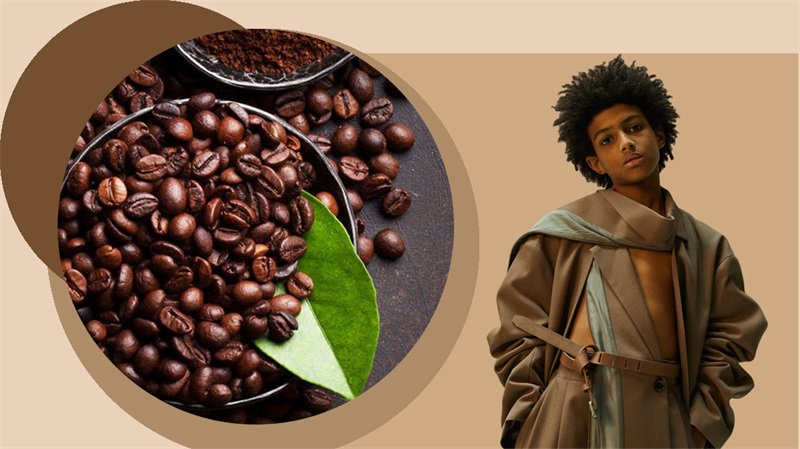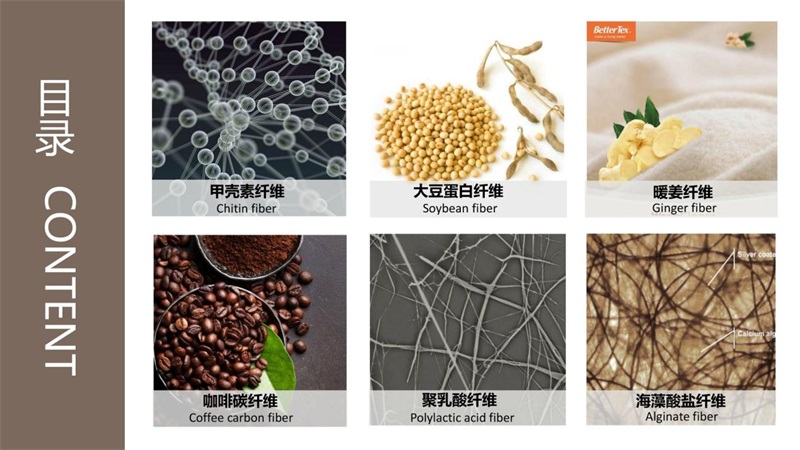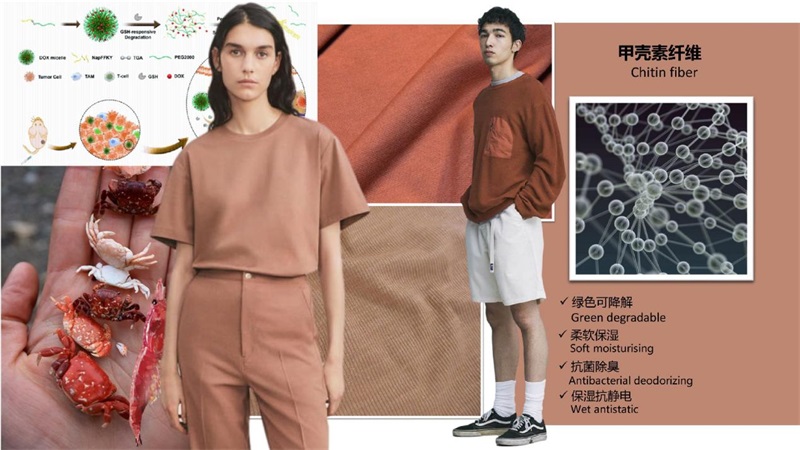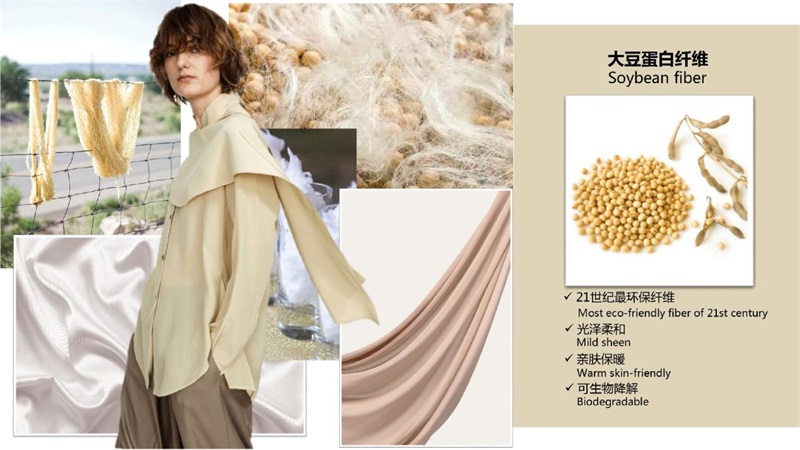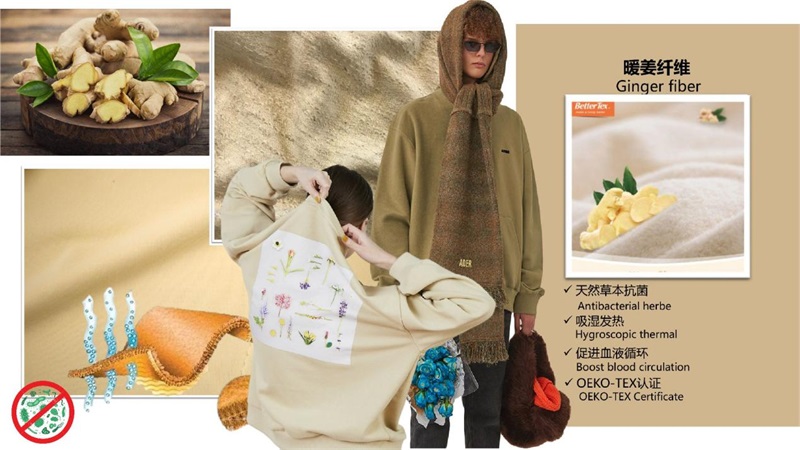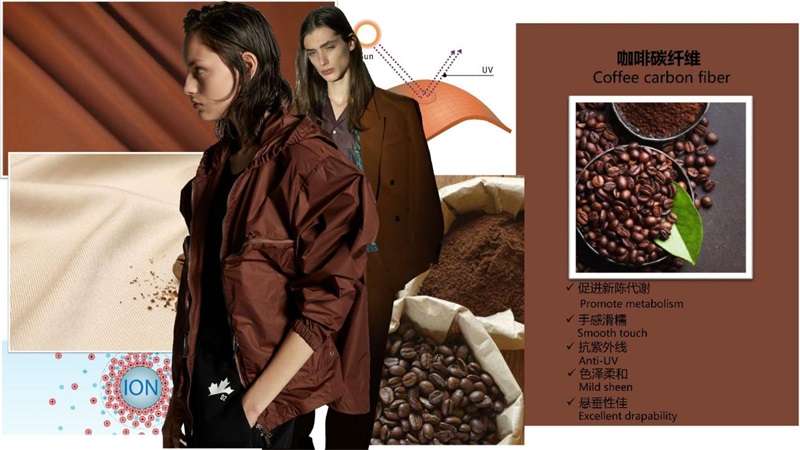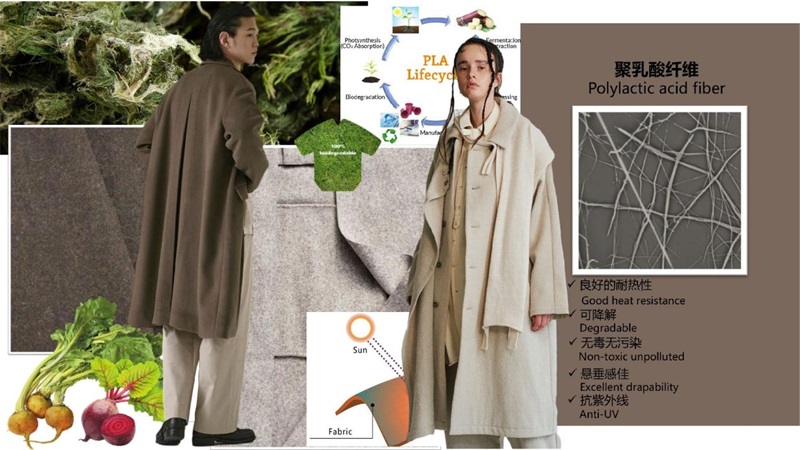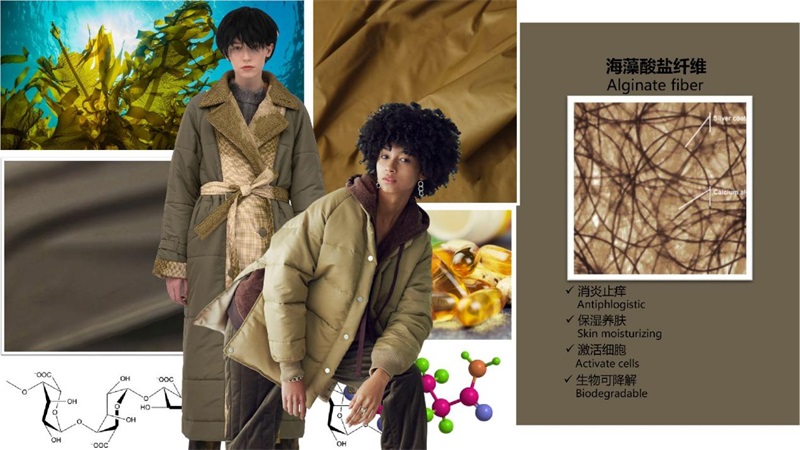Since mankind entered the 21st century, with the increasing depletion of global petrochemical resources and the strengthening of environmental awareness in the consumer goods market, natural polymer materials with sustainable development characteristics have become more and more important, and many raw materials are changing from chemical raw materials to natural extract raw materials. change. As a natural polymer material extracted from seaweed plants, alginate is getting more and more attention. In addition, chitin fiber, soybean protein fiber, warm ginger fiber, coffee charcoal fiber extracted from various animals and plants , Polylactic acid fiber is also getting more and more attention in the use of 2022 autumn and winter men’s and women’s clothing fabrics. Green energy is the only way for mankind to achieve sustainable development. Bio-based products and green energy issues have become the forefront of the world’s scientific and technological fields. Bio-based fiber fabrics will surely become an important trend in the development of fabrics in the future.
Chitin Fiber
Fabric concept: The structural material of the shell of crustaceans is chitin, which not only has a physiological function, but also protects the body from external mechanical shocks; at the same time, it also has the performance of absorbing high-energy radiation. Chitin and its derivative chitosan have a certain degree of flowability and filament-forming properties. They are both good fiber-forming materials. Select appropriate spinning conditions and can be made with high strength through conventional wet spinning processes. And the elongation of chitin fiber. Since the raw materials for the manufacture of chitin fiber generally use the wastes of shrimp and crab aquatic products, on the one hand, this can reduce the environmental pollution of such wastes, and on the other hand, the wastes of chitin fiber are biodegradable and will not pollute. The surrounding environment, so chitin fiber is also called green fiber. Chitin fiber has a large number of hydrophilic groups in its macromolecular chain, so the fiber has good hydrophilicity and high hygroscopicity. In addition, chitin fiber also has excellent dyeing properties, and can be dyed with direct, reactive, reduced, alkaline and sulfurized dyes, and the color is bright. Chitin fiber knitted fabric has the advantages of soft touch, no irritation, high moisture retention, antibacterial and deodorizing function, good skin care effect, and auxiliary medical function for allergic dermatitis, and conforms to the green textile standard. A new generation of health knitwear in the 21st century.
Fabric functional characteristics: soft and moisturizing, excellent dyeability, bright color, antibacterial and deodorizing, antistatic, environmentally friendly and biodegradable.
Fabric application: It can be spun purely or blended with cotton fiber, etc., suitable for making knitted garments for men and women.
Soy protein fiber
Fabric concept: Soy protein fiber belongs to the category of regenerated plant protein fiber. It uses food-grade soy protein powder as raw material and uses bioengineering technology to extract the globulin in the protein powder. By adding functional additives, it is high in nitrile and hydroxyl groups. The polymer is grafted, copolymerized and blended to make a certain concentration of protein spinning solution, which changes the protein spatial structure and is made by wet spinning. Soy protein fiber fabric has a soft feel better than cashmere, silky soft luster, better performance than cotton, such as warmth retention and good skin-friendliness. It is known as “healthy and comfortable fiber fabric in the new century” and “skin”. Good fabric that I like”. The production process of soybean protein fiber does not pollute the environment, air, human body, soil, water quality, etc. The fiber is mainly composed of soybean protein, and the fiber itself is easily biodegradable. The raw material of soybean fiber comes from natural soybeans. The raw material is rich and renewable, and it will not cause predatory development of resources. In the fiber production process, because the auxiliary materials and additives used are non-toxic, and most of the additives and semi-finished fibers can be recycled and reused, the residue left after the protein is extracted can also be used as feed. Soy protein fiber is praised by experts It is “the most environmentally friendly fiber in the 21st century”. Soy protein fiber fabric has better acid and alkali resistance than wool and silk; mold resistance is better than wool and silk; insect resistance is better than wool and silk.
Fabric functional characteristics: better than cashmere hand feel, soft luster, skin-friendly and warmth, biodegradable, green and environmentally friendly.
Fabric application: Soy protein fiber can be blended with various natural fibers and chemical fibers. It is suitable for the R&D and design of men’s and women’s shirts, suits, T-shirts, and sweaters.
Warm ginger fiber
Fabric concept: Warm ginger fiber is taken from natural plant ginger, and the gingerol in ginger is extracted, melted into the spinning melt, and then processed by spinning to make warm ginger fiber fabric. Warm ginger fiber has good antibacterial properties, has a good inhibitory effect on common Staphylococcus aureus, Escherichia coli, Candida albicans, and can also promote blood circulation on the skin surface and accelerate the human body to heat up. It has passed the harmful substance test OEKO-TEX certification.
Fabric functional characteristics: natural herb antibacterial, moisture absorption and heat generation.
Fabric application: It can be spun purely or blended with any other fiber, suitable for the research and development and design of knitted garments for men and women.
Coffee charcoal fiber
Fabric concept: Coffee carbon fiber is a kind of functional polyester staple fiber that uses the coffee grounds left over after drinking the coffee, which is calcined into crystals, and then ground into nanometer powder, which is added to the polyester fiber to produce a functional polyester staple fiber. The nicotinic acid of coffee is rich in vitamin B, and free fatty acids, caffeine, tannins, etc. can promote metabolism, and direct contact is beneficial to the skin. The fabric containing coffee charcoal fiber feels smooth and waxy, soft and comfortable to the touch, good drape, and soft color. It maintains the characteristics of coffee charcoal fabrics such as skin-friendly and moisturizing, antibacterial and deodorization, heat storage and heating, emission of negative ions, anti-ultraviolet rays, and prevention of static electricity. On the basis of the fabric, the hand feeling effect and skin touch of the fabric are better than other fabrics.
Fabric functional characteristics: natural and environmentally friendly, good heat preservation, antibacterial and deodorization, emission of negative ions, skin-friendly and moisturizing, anti-ultraviolet, and anti-static.
Fabric application: It can be spun purely or blended with any other fiber, suitable for shirts, jackets, windbreakers, trousers and other categories.
Polylactic acid fiber
Fabric concept: Polylactic acid fiber can also be called corn fiber. It is made from corn, wheat, sugar beet and other starch-containing agricultural products. After fermentation, lactic acid is produced, and then polycondensation and melt spinning are made. It has good heat resistance. Polylactic acid fiber is a synthetic fiber whose raw material can be planted and easily planted, and the waste can be naturally degraded in nature. It can be decomposed into carbon dioxide and water under the action of microorganisms in the soil or seawater, and the two can become the raw material of lactic acid-starch through photosynthesis. In addition, when burned, this fiber will not emit poisonous gas and cause no pollution. It is a sustainable ecological fiber. When used in woven fabrics, it not only has a good hand feel, good drape, but also can effectively resist ultraviolet rays, has low flammability and excellent processing properties.
Fabric functional characteristics: good drape, non-toxic, non-polluting, biodegradable, excellent heat resistance, good hand feeling, UV resistance.
Fabric application: The fiber can be purely imitated or blended with any other fiber, which is suitable for making all kinds of knitted garments for men and women.
Alginate fiber fabric
Fabric concept: Alginate fiber is a new type of fiber obtained by wet spinning production process with polysaccharide extracted from natural seaweed as raw material, water-soluble metal salt solution as coagulation bath. The seaweed accumulates abundant minerals from the ocean, and contains carbohydrates, amino acids, fats and various vitamins. It can activate cell metabolism, has anti-inflammatory and anti-itching functions, and makes alginate fiber natural maintenance of human skin. , Moisturizing, beautifying effect, at the same time for the treatment of skin diseases is also a special purpose. In addition, alginate fiber also has good biodegradability, biocompatibility and excellent moisture absorption, flame retardancy and electromagnetic shielding capabilities.
Fabric functional characteristics: moisturizing and nourishing skin, biodegradable, activating cell metabolism, good flame retardancy.
Fabric application: It can be spun purely or blended with any fiber. It is suitable for making high-end men’s and women’s outerwear, cotton down jackets, trousers, etc. and protective clothing.
Post time: Apr-20-2021

